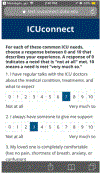Improving racial disparities in unmet palliative care needs among intensive care unit family members with a needs-targeted app intervention: The ICUconnect randomized clinical trial
- PMID: 33592310
- PMCID: PMC8330133
- DOI: 10.1016/j.cct.2021.106319
Improving racial disparities in unmet palliative care needs among intensive care unit family members with a needs-targeted app intervention: The ICUconnect randomized clinical trial
Abstract
Introduction: The technologies used to treat the millions who receive care in intensive care unit (ICUs) each year have steadily advanced. However, the quality of ICU-based communication has remained suboptimal, particularly concerning for Black patients and their family members. Therefore we developed a mobile app intervention for ICU clinicians and family members called ICUconnect that assists with delivering need-based care.
Objective: To describe the methods and early experiences of a clustered randomized clinical trial (RCT) being conducted to compare ICUconnect vs. usual care.
Methods and analysis: The goal of this two-arm, parallel group clustered RCT is to determine the clinical impact of the ICUconnect intervention in improving outcomes overall and for each racial subgroup on reducing racial disparities in core palliative care outcomes over a 3-month follow up period. ICU attending physicians are randomized to either ICUconnect or usual care, with outcomes obtained from family members of ICU patients. The primary outcome is change in unmet palliative care needs measured by the NEST instrument between baseline and 3 days post-randomization. Secondary outcomes include goal concordance of care and interpersonal processes of care at 3 days post-randomization; length of stay; as well as symptoms of depression, anxiety, and post-traumatic stress disorder at 3 months post-randomization. We will use hierarchical linear models to compare outcomes between the ICUconnect and usual care arms within all participants and assess for differential intervention effects in Blacks and Whites by adding a patient-race interaction term. We hypothesize that both compared to usual care as well as among Blacks compared to Whites, ICUconnect will reduce unmet palliative care needs, psychological distress and healthcare resource utilization while improving goal concordance and interpersonal processes of care. In this manuscript, we also describe steps taken to adapt the ICUconnect intervention to the COVID-19 pandemic healthcare setting.
Enrollment status: A total of 36 (90%) of 40 ICU physicians have been randomized and 83 (52%) of 160 patient-family dyads have been enrolled to date. Enrollment will continue until the end of 2021.
Keywords: Critical illness; Electronic health record (EHR) systems; Intensive care units; Mobile app; Palliative care; Racial health disparities; Randomized clinical trial (RCT).
Copyright © 2021. Published by Elsevier Inc.
Conflict of interest statement
Competing interests statement
No author has conflicts of interest to report relevant to this manuscript.
Figures
References
-
- Institute of Medicine. Dying in America: improving quality and honoring individual preferences near the end of life. National Academies Press, Washington, D.C., 2014. - PubMed
-
- Meier D, Morrison RS. Center to Advance Palliative Care: Report Card. http://reportcard.capc.org/pdf/state-by-state-report-card.pdf
References for Appendix 1
-
- Nielsen J. Usability 101: Introduction to usability, (2012).
-
- Usability.gov. Research-Based Web Design & Usability Guidelines, 2013.
References for Appendix 2
-
- Sandelowski M. Unmixing mixed-methods research. Res Nurs Health 37 (2014) 3–8. - PubMed
-
- Bazeley P. Integrative analysis strategies for mixed data sources. Am Behav Scientist 56 (2012) 814–828.
-
- Saldana J. The coding manual for qualitative researchers. 3rd edition. ed., Sage Publications, Thousand Oaks, CA, 2015.
Publication types
MeSH terms
Grants and funding
LinkOut - more resources
Full Text Sources
Other Literature Sources
Medical






